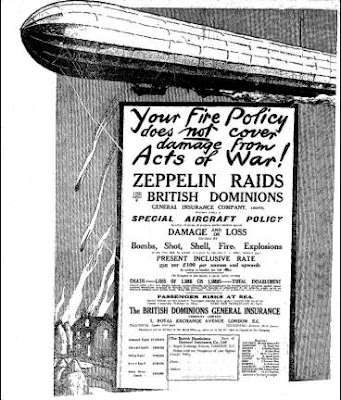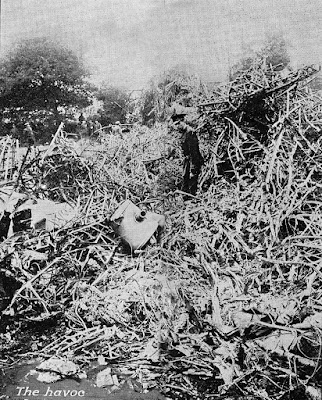 |
| A Zeppelin Bomber in flight with a smoking (?) engine, possibly caused by an allied attack. [Source : History on the Net] |
German Army and Navy hydrogen filled Airships began their bombing raids over Southern England with varied success on the 19th January 1915. Their bomb load consisted of both high explosive bombs and incendiaries. The incendiaries consisted of simple metal canisters filled with a mix of thermite, tar, and benzol; then being being wrapped in tarred rope and fitted with a simple fuse.
 |
| A period newspaper report of a Zeppelin raid. [Source : World War I - Trenches on the Web] |
British aerial defences had up until 1916 proved ineffectual. In February 1916 the British Army took over full control of ground defences and a variety of sub 4-inch calibre guns were converted for anti-aircraft use. Searchlights manned by Police were also introduced, initially manned by police. By mid1916 there were 271 anti-aircraft guns and 258 searchlights across England.
 |
| A Fire Insurance Advertisement from 1915 [Source : Arborfileld Local History Society] |
New BE12 fighters now fitted with interrupter gear and Lewis machine guns firing a mix of explosive, incendiary and tracer rounds were slowly introduced from mid 1916. But the German's were also further developing their airships. Their new Q-class Zeppelin with an additional 100,000 cubic feet of gas enabled the length to be extended to 585 feet, improving both ceiling limits and bomb-load.
But the turning point came on the night of the 2nd September 1916 when Lt. William Leefe Robinson, firing three drums of bullets from his Lewis gun, managed to set alight German Army Airship SL.11 commanded by Hauptmann Wilhelm Schramm. Built by Luftschiffbau Schütte-Lanz (and therefore not actually classed as a 'Zeppelin'), it carried four Maybach engines developing an impressive 960 hp capable of propelling the airship at 91.8 kph. The airship, which quickly became enveloped in flames, crashed at Cuffley in Hertfordshire. Propaganda possibly intentionally misidentified the airship as one of the already feared "Zeppelins". The crew (listed at the bottom of this page) were initially buried at Potters Bar Cemetery but in 1962 were re-interred at Cannock Chase German War Cemetery in Staffordshire.
For downing the first rigid airship on British soil and for the first 'night fighter' victory Robinson received the Victoria Cross. Robinson, his health being badly affected during his time as a Prisoner of War in 1917-18, succumbed to Spanish Influenza during the Pandemic and died on the 31st December 1918.
The loss of SL.11 ended the German Army's interest in Airship warfare over England but the German Navy continued to aggressively pursue this form of aerial combat. On the night of the 23rd September three M-class airships, including L.32, attacked London. L32 was the second of the 650ft M-class "Super Zeppelins", being powered by six engines and capable of operating at 13,000 ft (with another 5,000 ft to its maximum ceiling) while carrying up to four tons of bombs.
At 1.10am a BE2c fighter plane piloted by 2nd Lieutenent Frederick Sowrey attacked L.32. Despite fire being returned he fired three drums of explosive bullets until a fire finally took hold, possibly helped by a burning petrol tank. Flames swiftly spread throughout the airship, bursting through the outer envelope in several places. An eye-witness recalled that "The flames crept along the back of the Zeppelin, which appeared to light up in sections... until it was burning from end to end." The great airship finally crashed to the ground near Great Burstead in Essex. Again, there were no survivors, the Commander, Oberleutnant-zur-See Werner Peterson, choosing to jump rather than burn to death in the inferno. Sowrey survived the war and died in 1968.
 |
| "Examining the Debris" of L.32 at Snail's Hall Farm, Great Burstead |
At 1.10am a BE2c fighter plane piloted by 2nd Lieutenent Frederick Sowrey attacked L.32. Despite fire being returned he fired three drums of explosive bullets until a fire finally took hold, possibly helped by a burning petrol tank. Flames swiftly spread throughout the airship, bursting through the outer envelope in several places. An eye-witness recalled that "The flames crept along the back of the Zeppelin, which appeared to light up in sections... until it was burning from end to end." The great airship finally crashed to the ground near Great Burstead in Essex. Again, there were no survivors, the Commander, Oberleutnant-zur-See Werner Peterson, choosing to jump rather than burn to death in the inferno. Sowrey survived the war and died in 1968.
 |
| "The Great Bulk of Girders" of L.32 at Snail's Hall Farm |
The same night L.33, despite being at 13,000 feet, was hit by anti-aircraft fire, thereafter being forced to the ground, landing near Little Wigborough. The crew set the Zeppelin alight but sufficient of the wreckage remained to be of valuable use to the British in their own rigid airship research.
 |
| "A Propellor" from L.32 |
 |
| "The Lower Structure" of L.32 |
 |
| "Assorted Fragments" of L.32 |
 |
| "A Side Propeller" from L.32 |
 |
| The damage caused by a bomb dropped on Baytree Road, Brixton from Zeppelin L.31 on the night of the 23 Sept 1916. [Source : Ideal Homes] |
The crew of both SL.11 and L.32 (listed below) are now buried at Cannock Chase German War Cemetery in Staffordshire, England.
The Crew of SL.11
Wilhelm SCHRAMM Hauptmann
Jakob BAUMANN Obermaschinist
Hans GEITEL Leutnant
Rudolf GOLTZ Vizefeldwebel
Karl HASSENMULLER Feldwebel-Leutnant
Bernhard JEZIORSKI Gefreiter
Fritz JOURDAN Untermaschinist
Karl KACHELE Untermaschinist
Fritz KOPISCHKE Obersteuermann
Friedrich MODINGER Obermaschinist
Reinhold PORATH Obermaschinist
Rudolf SENDZICK Obersteuermann
Heinrich SCHLICHTING Unteroffizier
Anton TRISTRAM Unteroffizier
Wilhelm VOHDIN Oberleutnant
Hans WINKLER Untermaschinist
The Crew of L.32
Werner PETERSON Oberleutnant Zur See
Adolf BLEY Obersignalmaat
Albin BOCKSCH Obermaschinistmaat
Karl BORTSCHELLER Funkentelegrafieobermaat
Wilhelm BROCKHAUS Oberheizer
Karl BRODRUCK Leutnant Zur See
Paul DORFMULLER Maschinistenmaat
Richard FANKHANEL Obermaschinistenmaat
Georg HAGEDORN Obermaschinistenmaat
Friedrich HEIDER Oberbootsmannsmaat
Robert KLISCH Funkentelegrafieobergast
Herman MAEGDLFRAU Obermaschinistenmaat
Bernhard MOHR Obersegelmachersgast
August MULLER Matrose
Friedrich PASCHE Bootsmannsmaat
Karl PAUST Obermaschinistenmaat
Ewald PICARD Obersignalmaat
Walter PRUSS Maschinistenmaat
Paul SCHIERING Obermatrose
Bernhard SCHREIBMULLER Steuermann
Karl VOLKER Obermaschinistenmaat
Alfred ZOPEL Oberbootsmannsmaat
Bibliography :
- "The Graphic" 1916 (from my own collection)
- Wikipedia
- The Great War Forum
- The Great War Forum
- First World War.com - A Multimedia History of World War One
- Unless otherwise stated all images are from my own collection but may be freely copied for non-commercial use provided a link is given back to this page.







Warfare is a fascinating subject. Despite the dubious morality of using violence to achieve personal or political aims. It remains that conflict has been used to do just that throughout recorded history.
ReplyDeleteYour article is very well done, a good read.